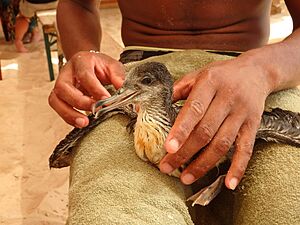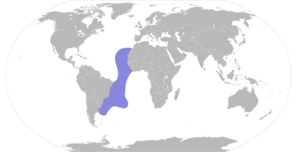Cape Verde shearwater facts for kids
Quick facts for kids Cape Verde shearwater |
|
|---|---|
 |
|
| Conservation status | |
| Scientific classification | |
| Genus: |
Calonectris
|
| Species: |
edwardsii
|
 |
|
The Cape Verde shearwater (also called Calonectris edwardsii) is a special type of seabird. Locals in Cape Verde call it "cagarra." It's a medium-sized bird that belongs to the petrel family. This bird lives only in the Cape Verde islands, which are a group of islands in the Atlantic Ocean near West Africa.
Contents
What is a Cape Verde Shearwater?
Scientists first described the Cape Verde shearwater in 1883. At first, they thought it was its own unique species. Later, some scientists grouped it with another bird called Cory's shearwater. But in 1995, a scientist named Cornelis Hazevoet showed that it was indeed a separate species again.
What Does This Bird Look Like?
The Cape Verde shearwater has a thin, dark bill. Its head and upper body are darker than a similar bird, Cory's shearwater. When it flies, it moves its wings in a stiff, quick way, which is typical for shearwaters. It looks smaller and thinner than Cory's shearwater.
Where Do Cape Verde Shearwaters Live?
These shearwaters only breed on the Cape Verde Islands. The biggest groups of these birds live on the islands of Brava, Branco, and Raso. They also breed in smaller numbers on other islands in the area.
Where Do They Go After Breeding?
We don't know much about where they go when they are not breeding. But they are often seen around the islands during the breeding season. After breeding, they spread out. Some have been seen near Senegal in October. A few have even been spotted far away, near the eastern coast of North America.
How Do Cape Verde Shearwaters Behave?
Breeding Habits
Adult shearwaters return to their island homes in late February and March. They have been away for about three months. They build their nests in hollows on cliffs, on rocks near the shore, or under large rocks.
The female bird lays only one egg. The parents take turns sitting on the egg from May to July. The young chicks learn to fly from late September to November. After they learn to fly, all the birds stay at sea until the next breeding season.
What Do They Eat?
Like other shearwaters, these birds find all their food in the ocean. They eat small fish, squid, and other tiny sea creatures.
Are Cape Verde Shearwaters in Danger?
In 1993, scientists estimated there were about 20,000 adult Cape Verde shearwaters. This means there were about 10,000 pairs of breeding birds.
Why Are Their Numbers Dropping?
Even though the Cape Verde shearwater is a protected species, its chicks are still collected by fishermen for food. About 5,000 young birds are taken from their nests on Branco and Raso islands each year. This is called "muttonbirding." Because too many young birds are being taken, their numbers have gone down. This is why the species is now considered "near threatened" by conservation groups.


